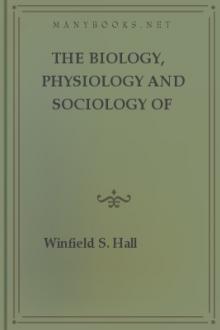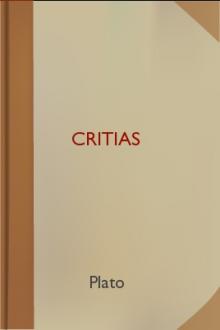Illusions, James Sully [speld decodable readers .TXT] 📗

- Author: James Sully
- Performer: -
Book online «Illusions, James Sully [speld decodable readers .TXT] 📗». Author James Sully
For these reasons dreams may properly be classed with the illusions of normal or healthy life, rather than with those of disease. They certainly lie nearer this region than the very similar illusions of the somnambulist, which with respect to their origin appear to be more distinctly connected with a pathological condition of the nervous system, and which, with respect to their practical consequences may easily prove so disastrous.
After-Dreams.
In concluding this account of dreams, I would call attention to the importance of the transition states between sleeping and waking, in relation to the production of sense-illusion. And this point may be touched on here all the more appropriately, since it helps to bring out the close relation between waking and sleeping illusion. The mind does not pass suddenly and at a bound from the condition of dream-fancy to that of waking perception. I have already had occasion to touch on the "hypnagogic state," that condition of somnolence or "sleepiness" in which external impressions cease to act, the internal attention is relaxed, and the weird imagery of sleep begins to unfold itself. And just as there is this anticipation of dream-hallucination in the presomnial condition, so there is the survival of it in the postsomnial condition. As I have observed, dreams sometimes leave behind them, for an appreciable interval after waking, a vivid after-impression, and in some cases even the semblance of a sense-perception.
If one reflects how many ghosts and other miraculous apparitions are seen at night, and when the mind is in a more or less somnolent condition, the idea is forcibly suggested that a good proportion of these visions are the débris of dreams. In some cases, indeed, as that of Spinoza, already referred to, the hallucination (in Spinoza's case that of "a scurvy black Brazilian") is recognized by the subject himself as a dream-image.[101] I am indebted to Mr. W.H. Pollock for a fact which curiously illustrates the position here adopted. A lady was staying at a country house. During the night and immediately on waking up she had an apparition of a strange-looking man in mediæval costume, a figure by no means agreeable, and which seemed altogether unfamiliar to her. The next morning, on rising, she recognized the original of her hallucinatory image in a portrait hanging on the wall of her bedroom, which must have impressed itself on her brain before the occurrence of the apparition, though she had not attended to it. Oddly enough, she now learnt for the first time that the house at which she was staying had the reputation of being haunted, and by the very same somewhat repulsive-looking mediæval personage that had troubled her inter-somnolent moments. The case seems to me to be typical with respect to the genesis of ghosts, and of the reputation of haunted houses.
NOTE. THE HYPNOTIC CONDITION.I have not in this chapter discussed the relation of dreaming to hypnotism, or the state of artificially produced quasi-sleep, because the nature of this last is still but very imperfectly understood. In this condition, which is induced in a number of ways by keeping the attention fixed on some non-exciting object, and by weak continuous and monotonous stimulation, as stroking the skin, the patient can be made to act conformably to the verbal or other suggestion of the operator, or to the bodily position which he is made to assume. Thus, for example, if a glass containing ink is given to him, with the command to drink, he proceeds to drink. If his hands are folded, he proceeds to act as if he were in church, and so on.
Braid, the writer who did so much to get at the facts of hypnotism, and Dr. Carpenter who has helped to make known Braid's careful researches, regard the actions of the hypnotized subject as analogous to ideomotor movements; that is to say, the movements due to the tendency of an idea to act itself out apart from volition. On the other hand, one of the latest inquirers into the subject, Professor Heidenhain, of Breslau, appears to regard these actions as the outcome of "unconscious perceptions" (Animal Magnetism, English translation, p. 43, etc.).
In the absence of certain knowledge, it seems allowable to argue from the analogy of natural sleep that the actions of the hypnotized patient are accompanied with the lower forms of consciousness, including sensation and perception, and that they involve dream-like hallucinations respecting the external circumstances of the moment. Regarding them in this light, the points of resemblance between hypnotism and dreaming are numerous and striking. Thus, Dr. Heidenhain tells us that the threshold or liminal value of stimulation is lowered just as in ordinary sleep sense-activity as a whole is lowered. According to Professor Weinhold, the hypnotic condition begins in a gradual loss of taste, touch, and the sense of temperature; then sight is gradually impaired, while hearing remains throughout the least interfered with.[102] In this way, the mind of the patient is largely cut off from the external world, as in sleep, and the power of orientation is lost. Moreover, there are all the conditions present, both positive and negative, for the hallucinatory transformation of mental images into percepts just as in natural sleep. Thus, the higher centres connected with the operations of reflection and reasoning are thrown hors de combat or, as Dr. Heidenhain has it, "inhibited."
The condition of hypnotism is marked off from that of natural sleep, first of all, by the fact that the accompanying hallucinations are wholly due to external suggestion (including the effects of bodily posture). Dreams may, as we have seen, be very faintly modified by external influences, but during sleep there is nothing answering to the perfect control which the operator exercises over the hypnotized subject. The largest quantity of our "dream-stuff" comes, as we have seen, from within and not from without the organism. And this fact accounts for the chief characteristic difference between the natural and the hypnotic dream. The former is complex, consisting of crowds of images, and continually changing: the latter is simple, limited, and persistent. As Braid remarks, the peculiarity of hypnotism is that the attention is concentrated on a remarkably narrow field of mental images and ideas. So long as a particular bodily posture is assumed, so long does the corresponding illusion endure. One result of this, in connection with that impairing of sensibility already referred to, is the scope for a curious overriding of sense-impressions by the dominant illusory percept, a process that we have seen illustrated in the active sense-illusions of waking life. Thus, if salt water is tasted and the patient is told that it is beer, he complains that it is sour.
In being thus in a certain rapport, though so limited and unintelligent a rapport, with the external world, the mind of the hypnotized patient would appear to be nearer the condition of waking illusion than is the mind of the dreamer. It must be remembered, however, and this is the second point of difference between dreaming and hypnotism, that the hypnotized subject tends to act out his hallucinations. His quasi-percepts are wont to transform themselves into actions with a degree of force of which we see no traces in ordinary sleep. Why there should be this greater activity of the motor organs in the one condition than in the other, seems to be a point as yet unexplained. All sense-impressions and percepts are doubtless accompanied by some degree of impulse to movement, though, for some reason or another, in natural and healthy sleep these impulses are restricted to the stage of faint nascent stirrings of motor activity which hardly betray themselves externally. This difference, involving a great difference in the possible practical consequences of the two conditions of natural and hypnotic sleep, clearly serves to bring the latter condition nearer to that of insanity than the former condition is brought. A strong susceptibility to the hypnotic influence, such as Dr. Heidenhain describes, might, indeed, easily prove a very serious want of "adaptation of internal to external relations," whereas a tendency to dreaming would hardly prove a maladaptation at all.
CHAPTER VIII. ILLUSIONS OF INTROSPECTION.We have now, perhaps, sufficiently reviewed sense-illusions, both of waking life and of sleep. And having roughly classified them according to their structure and origin, we are ready to go forwards and inquire whether the theory thus reached can be applied to other forms of illusory error. And here we are compelled to inquire at the outset if anything analogous to sense-illusion is to be found in that other great region of presentative cognition usually marked off from external perception as internal perception, self-reflection, or introspection.
Illusions of Introspection defined.
This inquiry naturally sets out with the question: What is meant by introspection? This cannot be better defined, perhaps, than by saying that it is the mind's immediate reflective cognition of its own states as such.
In one sense, of course, everything we know may be called a mental state, actual or imagined. Thus, a sense-impression is known, exactly like any other feeling of the mind, as a mental phenomenon or mental modification. Yet we do not usually speak of introspectively recognizing a sensation. Our sense-impressions are marked off from all other feelings by having an objective character, that is to say, an immediate relation to the external world, so that in attending to one of them our minds pass away from themselves in what Professor Bain calls the attitude of objective regard. Introspection is confined to feelings which want this intimate connection with the external region, and includes sensation only so far as it is viewed apart from external objects and on its mental side as a feeling, a process which is next to impossible where the sensation has little emotional colour, as in the case of an ordinary sensation of sight or of articulate sound.
This being so, errors of introspection, supposing such to be found, will in the main be sufficiently distinguished from those of perception. Even an hallucination of sense, whether setting out from a subjective sensation or not, always contains the semblance of a sense-impression, and so would not be correctly classed with errors of introspection.
Just as introspection must be marked off from perception, so must it be distinguished from memory. It may be contended that, strictly speaking, all introspection is retrospection, since even in attending to a present feeling the mind is reflectively representing to itself the immediately preceding momentary experience of that feeling. Yet the adoption of this view does not hinder us from drawing a broad distinction between acts of introspection and acts of memory. Introspection must be regarded as confined to the knowledge of immediately antecedent mental states with reference to which, no error of memory can be supposed to arise.
It follows from this that an illusion of introspection could only be found in connection with the apprehension of present or immediately antecedent mental states. On the other hand, any illusions connected with the consciousness of personal continuity and identity would fall rather under the class of mnemonic than that of introspective error.
Once more, introspection must be carefully distinguished from what I have called belief. Some of our beliefs may be found to grow out of and be compounded of a number of introspections. Thus, my conception of my own character, or my psychological conception of mind as a whole, may be seen to arise by a combination of the results of a number of acts of





Comments (0)